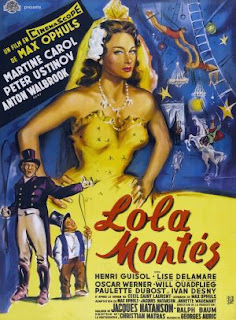 Lola Montes is a spectacle film and not too much more, but what it does it does very well. The opening of the film, coinciding with the opening of the circus, is glorious, ambitious, and dazzling. Deep reds and blues and sparkling jewels are everywhere; rows of performers juggle in synchronization, the music is blaring, and the beautiful Lola is paraded out, stoic and iconic, all while the camera whirls and twirls in and around everything. It’s a brilliant introduction, but a fatal one, as nothing in the film comes close to satisfying what these first few minutes set up. That is not to say that the grandeur is not sustained; every moment of the circus that plays out throughout the film is equally dazzling and entertaining, but the lack of progression is irksome, mainly because, as the meat of the story progresses in intermittent flashbacks, the substance of Ophuls’ vision wears thinner and thinner, until it is completely transparent, leaving only the trumpets, lights, and the show as its contribution.
Lola Montes is a spectacle film and not too much more, but what it does it does very well. The opening of the film, coinciding with the opening of the circus, is glorious, ambitious, and dazzling. Deep reds and blues and sparkling jewels are everywhere; rows of performers juggle in synchronization, the music is blaring, and the beautiful Lola is paraded out, stoic and iconic, all while the camera whirls and twirls in and around everything. It’s a brilliant introduction, but a fatal one, as nothing in the film comes close to satisfying what these first few minutes set up. That is not to say that the grandeur is not sustained; every moment of the circus that plays out throughout the film is equally dazzling and entertaining, but the lack of progression is irksome, mainly because, as the meat of the story progresses in intermittent flashbacks, the substance of Ophuls’ vision wears thinner and thinner, until it is completely transparent, leaving only the trumpets, lights, and the show as its contribution.
There are occasional bits that work, though. Lola’s relationship with her mother is well established, and provided rare insight into the isolating fame and stunted growth that defined her developing years. Lola, despite being in her late teens, still desires to share a cabin with her mother, who would secretly rather share her cabin with a man. Lola goes off to sleep in the dormitory with the other kiddies, and is teased for bursting into tears, knowing now that her happiness is not her mother’s sole passion. And later, the arbitrary satisfaction of Lola’s love is brilliantly shown as her lover hires an artist to paint a portrait of Lola. He takes great care to select the slowest, more meticulous painter, and encourages his mistakes and redos so that Lola will be obligated to stick around (or that he will have a reason to keep her around).
Lola is courted by four men (four of supposedly over a dozen lovers from her life, if her circus master and current hubby are to be believed) throughout the film, one for each season. This roundabout coverage of the course of a year, and drama and seemingly imminent doom of her brush with death at the end make this film seem like it is a complete account of Lola’s life. We’ve seen her spring, summer, autumn, and winter flings, her adolescence, her exploitation, and her general lifelessness (which is only interrupted in the film’s best scene in which she interrupts a performance to stomp through and over a party to approach her lover’s wife). The long, flowing line of men and boys paying to touch or kiss Lola is disturbingly endless, turning her into a kind of family-friendly whore. It’s a satisfying ending to a dry, engaging, and busy film about a woman who doesn’t deserve one.
